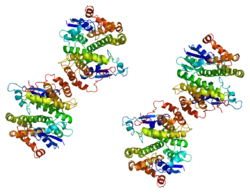GSTM4
Glutathione S-transferase Mu 4 is an enzyme that in humans is encoded by the GSTM4 gene.[5][6]
| GSTM4 | |||||||||||||||||||||||||||||||||||||||||||||||||||
|---|---|---|---|---|---|---|---|---|---|---|---|---|---|---|---|---|---|---|---|---|---|---|---|---|---|---|---|---|---|---|---|---|---|---|---|---|---|---|---|---|---|---|---|---|---|---|---|---|---|---|---|
 | |||||||||||||||||||||||||||||||||||||||||||||||||||
| |||||||||||||||||||||||||||||||||||||||||||||||||||
| Identifiers | |||||||||||||||||||||||||||||||||||||||||||||||||||
| Aliases | GSTM4, GSTM4-4, GTM4, glutathione S-transferase mu 4 | ||||||||||||||||||||||||||||||||||||||||||||||||||
| External IDs | OMIM: 138333 MGI: 95862 HomoloGene: 37357 GeneCards: GSTM4 | ||||||||||||||||||||||||||||||||||||||||||||||||||
| |||||||||||||||||||||||||||||||||||||||||||||||||||
| |||||||||||||||||||||||||||||||||||||||||||||||||||
| |||||||||||||||||||||||||||||||||||||||||||||||||||
| |||||||||||||||||||||||||||||||||||||||||||||||||||
| |||||||||||||||||||||||||||||||||||||||||||||||||||
| Wikidata | |||||||||||||||||||||||||||||||||||||||||||||||||||
| |||||||||||||||||||||||||||||||||||||||||||||||||||
Cytosolic and membrane-bound forms of glutathione S-transferase are encoded by two distinct supergene families. At present, eight distinct classes of the soluble cytoplasmic mammalian glutathione S-transferases have been identified: alpha, kappa, mu, omega, pi, sigma, theta and zeta. This gene encodes a glutathione S-transferase that belongs to the mu class. The mu class of enzymes functions in the detoxification of electrophilic compounds, including carcinogens, therapeutic drugs, environmental toxins and products of oxidative stress, by conjugation with glutathione. The genes encoding the mu class of enzymes are organized in a gene cluster on chromosome 1p13.3 and are known to be highly polymorphic. These genetic variations can change an individual's susceptibility to carcinogens and toxins as well as affect the toxicity and efficacy of certain drugs. Diversification of these genes has occurred in regions encoding substrate-binding domains, as well as in tissue expression patterns, to accommodate an increasing number of foreign compounds. Multiple transcript variants, each encoding a distinct protein isoform, have been identified.[6]
In the August 2009 issue of Oncogene journal, researchers at Huntsman Cancer Institute (HCI) at the University of Utah demonstrated that expression levels of GSTM4 could predict response to chemotherapy in patients with Ewing sarcoma. The study found that patients who did not respond to chemotherapy had high levels of GSTM4.[7]
References
- GRCh38: Ensembl release 89: ENSG00000168765 - Ensembl, May 2017
- GRCm38: Ensembl release 89: ENSMUSG00000027890 - Ensembl, May 2017
- "Human PubMed Reference:". National Center for Biotechnology Information, U.S. National Library of Medicine.
- "Mouse PubMed Reference:". National Center for Biotechnology Information, U.S. National Library of Medicine.
- Ross VL, Board PG, Webb GC (Feb 1994). "Chromosomal mapping of the human Mu class glutathione S-transferases to 1p13". Genomics. 18 (1): 87–91. doi:10.1006/geno.1993.1429. PMID 8276420.
- "Entrez Gene: GSTM4 glutathione S-transferase M4".
- OncoGenetics.Org (August 2009). "New hope for deadly childhood bone cancer". OncoGenetics.Org. Archived from the original on 2015-09-24. Retrieved 2009-08-31.
Further reading
- Bogaards JJ, van Ommen B, van Bladeren PJ (1992). "Purification and characterization of eight glutathione S-transferase isoenzymes of hamster. Comparison of subunit composition of enzymes from liver, kidney, testis, pancreas and trachea". Biochem. J. 286 (2): 383–8. doi:10.1042/bj2860383. PMC 1132909. PMID 1530570.
- Taylor JB, Oliver J, Sherrington R, Pemble SE (1991). "Structure of human glutathione S-transferase class Mu genes". Biochem. J. 274 (2): 587–93. doi:10.1042/bj2740587. PMC 1150179. PMID 2006920.
- Seidegård J, Vorachek WR, Pero RW, Pearson WR (1988). "Hereditary differences in the expression of the human glutathione transferase active on trans-stilbene oxide are due to a gene deletion". Proc. Natl. Acad. Sci. U.S.A. 85 (19): 7293–7. Bibcode:1988PNAS...85.7293S. doi:10.1073/pnas.85.19.7293. PMC 282172. PMID 3174634.
- Comstock KE, Widersten M, Hao XY, et al. (1994). "A comparison of the enzymatic and physicochemical properties of human glutathione transferase M4-4 and three other human Mu class enzymes". Arch. Biochem. Biophys. 311 (2): 487–95. doi:10.1006/abbi.1994.1266. PMID 8203914.
- Rozell B, Hansson HA, Guthenberg C, et al. (1994). "Glutathione transferases of classes alpha, mu and pi show selective expression in different regions of rat kidney". Xenobiotica. 23 (8): 835–49. doi:10.3109/00498259309059412. PMID 8284940.
- Comstock KE, Johnson KJ, Rifenbery D, Henner WD (1993). "Isolation and analysis of the gene and cDNA for a human Mu class glutathione S-transferase, GSTM4". J. Biol. Chem. 268 (23): 16958–65. doi:10.1016/S0021-9258(19)85287-0. PMID 8349586.
- Ross VL, Board PG (1993). "Molecular cloning and heterologous expression of an alternatively spliced human Mu class glutathione S-transferase transcript". Biochem. J. 294 (2): 373–80. doi:10.1042/bj2940373. PMC 1134464. PMID 8373352.
- Zhong S, Spurr NK, Hayes JD, Wolf CR (1993). "Deduced amino acid sequence, gene structure and chromosomal location of a novel human class Mu glutathione S-transferase, GSTM4". Biochem. J. 291 (1): 41–50. doi:10.1042/bj2910041. PMC 1132478. PMID 8471052.
- Patskovsky YV, Patskovska LN, Listowsky I (2000). "An asparagine-phenylalanine substitution accounts for catalytic differences between hGSTM3-3 and other human class mu glutathione S-transferases". Biochemistry. 38 (49): 16187–94. doi:10.1021/bi991714t. PMID 10587441.
- Beuckmann CT, Fujimori K, Urade Y, Hayaishi O (2000). "Identification of mu-class glutathione transferases M2-2 and M3-3 as cytosolic prostaglandin E synthases in the human brain". Neurochem. Res. 25 (5): 733–8. doi:10.1023/A:1007579507804. PMID 10905636. S2CID 36490150.
- Liloglou T, Walters M, Maloney P, et al. (2003). "A T2517C polymorphism in the GSTM4 gene is associated with risk of developing lung cancer". Lung Cancer. 37 (2): 143–6. doi:10.1016/S0169-5002(02)00078-8. PMID 12140136.
- Strausberg RL, Feingold EA, Grouse LH, et al. (2003). "Generation and initial analysis of more than 15,000 full-length human and mouse cDNA sequences". Proc. Natl. Acad. Sci. U.S.A. 99 (26): 16899–903. Bibcode:2002PNAS...9916899M. doi:10.1073/pnas.242603899. PMC 139241. PMID 12477932.
- Gerhard DS, Wagner L, Feingold EA, et al. (2004). "The status, quality, and expansion of the NIH full-length cDNA project: the Mammalian Gene Collection (MGC)". Genome Res. 14 (10B): 2121–7. doi:10.1101/gr.2596504. PMC 528928. PMID 15489334.
- Stelzl U, Worm U, Lalowski M, et al. (2005). "A human protein-protein interaction network: a resource for annotating the proteome". Cell. 122 (6): 957–68. doi:10.1016/j.cell.2005.08.029. hdl:11858/00-001M-0000-0010-8592-0. PMID 16169070. S2CID 8235923.
- Rual JF, Venkatesan K, Hao T, et al. (2005). "Towards a proteome-scale map of the human protein-protein interaction network". Nature. 437 (7062): 1173–8. Bibcode:2005Natur.437.1173R. doi:10.1038/nature04209. PMID 16189514. S2CID 4427026.
- Denson J, Xi Z, Wu Y, et al. (2006). "Screening for inter-individual splicing differences in human GSTM4 and the discovery of a single nucleotide substitution related to the tandem skipping of two exons". Gene. 379: 148–55. doi:10.1016/j.gene.2006.05.012. PMID 16854533.
External links
- Overview of all the structural information available in the PDB for UniProt: Q03013 (Glutathione S-transferase Mu 4) at the PDBe-KB.




